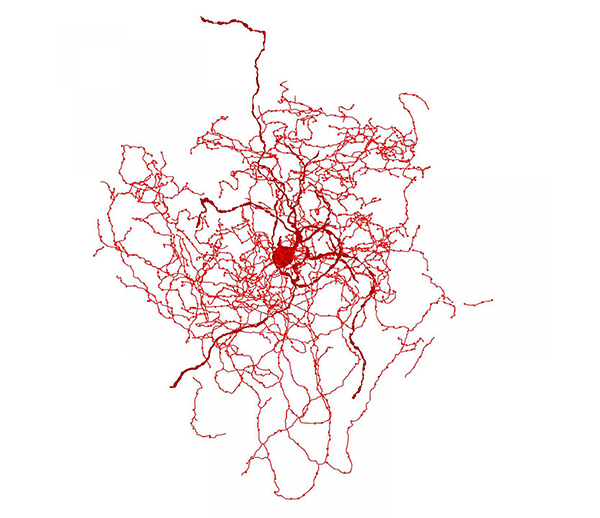Two research teams—one focused on gene expression, the other on cell shape and behavior—converged on a previously unknown type of brain cell. Because it resembles a rose deprived of its petals, the newly discovered brain cell has been called the “rosehip neuron.” Intriguingly, it may be unique to human brains, or at least primate brains, for nothing like it has ever been seen in rodents.
The rosehip neuron’s absence from rodents may help explain why mouse and rat models sometimes underperform as models of human neurological disease. On a more positive note, the rosehip neuron may help scientists better understand what sets human brains apart from those of different animals.
The two research teams published their findings together in a paper (“Transcriptomic and morphophysiological evidence for a specialized human cortical GABAergic cell type”) that appeared in the journal Nature Neuroscience. This paper described both gene expression data in support of the discovery, as well as data about the rosehip neurons shape and electrical activity. The gene expression data was obtained by scientists at the Allen Institute; the morphophysiological data, by scientists at the University of Szeged, in Szeged, Hungary.
The article summarized the gene expression findings as follows: “Using unbiased single-nucleus RNA sequencing, we identify ten GABAergic interneuron subtypes with combinatorial gene signatures in human cortical layer 1. These cells show an immunohistochemical profile (GAD1+CCK+, CNR1–SST–CALB2–PVALB–) matching a single transcriptomically defined cell type.”
The neurons, which have large rosehip-like axonal boutons and compact arborization, are unlike other circuit elements in the brain, morphophysiological evidence suggests: “Rosehip cells in layer 1 make homotypic gap junctions, predominantly target apical dendritic shafts of layer 3 pyramidal neurons, and inhibit backpropagating pyramidal action potentials in microdomains of the dendritic tuft. These cells are therefore positioned for potent local control of distal dendritic computation in cortical pyramidal neurons.”
“We really don't understand what makes the human brain special,” says Ed Lein, Ph.D., an investigator at the Allen Institute for Brain Science and a co-corresponding author of the current study. “Studying the differences at the level of cells and circuits is a good place to start, and now we have new tools to do just that.”
What appears to be unique about rosehip neurons is that they only attach to one specific part of their cellular partner, indicating that they might be controlling information flow in a very specialized way.
If you think of all inhibitory neurons like brakes on a car, the rosehip neurons would let your car stop in very particular spots on your drive, says Gábor Tamás, Ph.D., a neuroscientist at the University of Szeged and a co-corresponding author of the new study. They'd be like brakes that only work at the grocery store, for example, and not all cars (or animal brains) have them.
“This particular cell type—or car type—can stop at places other cell types cannot stop,” Dr. Tamás continues. “The car or cell types participating in the traffic of a rodent brain cannot stop in these places.”
In their study, the researchers used tissue samples from postmortem brains of two men in their 50s who had died and donated their bodies to research. They took sections of the top layer of the cortex, the outermost region of the brain that is responsible for human consciousness and many other functions that we think of as unique to our species. It's much larger, compared to our body size, than in other animals.
“Our brains are not just enlarged mouse brains,” notes Trygve Bakken, M.D., Ph.D., senior scientist at the Allen Institute for Brain Science and a co-author of the study. “People have commented on this for many years, but this study gets at the issue from several angles.”
The Allen Institute group, in collaboration with researchers from the J. Craig Venter Institute, found that the rosehip cells turn on a unique set of genes, a genetic signature not seen in any of the mouse brain cell types they've studied.
This is one of the first studies of the human cortex to combine these different techniques to study cell types, says Rebecca Hodge, Ph.D., senior scientist at the Allen Institute for Brain Science and an author on the study. “Alone, these techniques are all powerful, but they give you an incomplete picture of what the cell might be doing. Together, they tell you complementary things about a cell that can potentially tell you how it functions in the brain.”
The researchers' next step is to look for rosehip neurons in other parts of the brain, and to explore their potential role in brain disorders. Although scientists don't yet know whether rosehip neurons are truly unique to humans, the fact that they don't appear to exist in rodents is another strike against the laboratory mouse as a perfect model of human disease—especially for neurological diseases, the researchers said.







